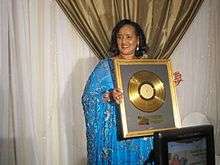Music of Somalia
 |
| Part of a series on the |
| Culture of Somalia |
|---|
| Culture |
| People |
| Religion |
| Language |
| Politics |
|
The music of Somalia refers to the musical styles, techniques and sounds of Somalia.
Overview
Traditional Somali music
Somalia has a rich musical heritage centered on traditional Somali folklore. Somali songs are pentatonic. That is, they only use five pitches per octave in contrast to a heptatonic (seven note) scale such as the major scale. At first listen, Somali music might be mistaken for the sounds of nearby regions such as Ethiopia, Sudan or the Arabian peninsula, but it is ultimately recognizable by its own unique tunes and styles. Somali songs are usually the product of collaboration between lyricists (lahamiste), songwriters (abwaan), and vocalists ('odka or "voice").[1]
Traditional instruments prominently featured in the music of the northern areas include the oud lute (kaban). It is often accompanied by small drums and a reed flute in the background. However, heavy percussion and metallic sounds are uncommon in the north.[1] The southern riverine and coastal areas use a wide variety of traditional instruments including:[2][3][4]
- Membranophones: nasaro, mokhoddon and masoondhe (high and heavy drums), reeme, jabbu and yoome (small drums);
- Aerophones: malkad and siinbaar (flutes), sumaari (double clarinet), fuugwo (trumpet) buun, muufe and gees-goodir (horns));
- Idiophones: shagal (metal clappers), shanbaal (wooden clappers), shunuuf (vegetable ankle rattles), tenegyo (xylophone),
- Chordophones: shareero (lyre), kinaandha (lute), madhuube (thumb piano), seese (one-chord violin)
History

The first major form of modern Somali music began in the mid-1930s, when northwestern Somalia was a part of the British Somaliland protectorate. This style of music was known as dhaanto, an innovative, urban form of Somali folk dance and song. This period also saw the rise of the Haji Bal Bal Dance Troupe, which became very influential over the course of its long career.

Somali popular music began with the balwo style, which was created by Abdi Sinimo. This style began in Dilla, and then spread throughout the area. It was a mixture of modern poetry and Somali dance music.
Abdullahi Qarshe rose to fame in the early 1940s as part of the qaraami style. Many qaraami songs from this era are still extremely popular today. This musical style is mostly played on the kaban (oud). Prominent Somali kaban players of the 1950s include Ali Feiruz and Mohamed Nahari.
During the Siad Barre regime, music was suppressed except for a small amount of officially-sanctioned music. There were many protest songs produced during this period.
Bands such as Waaberi and Horseed have gained a small following outside of the country. Others, like Ahmed Ali Egal, Maryam Mursal and Waayaha Cusub have fused traditional Somali music with pop, rock and roll, bossa nova, jazz, and other modern influences.
Music institutions
The first radio station in Somalia to air popular Somali music was Radio Kudu based in Hargeisa. It started broadcasting in 1943 in English, Somali and Arabic, before being renamed the following year to Radio Somali.[5] Somali music is now regularly broadcast on the state-run Radio Mogadishu, as well as a number of private radio and television networks such as Horn Cable Television.
List of Somali musicians

See also
Notes
References
- Abdullahi, Mohamed Diriye (2001). Culture and customs of Somalia. Greenwood. ISBN 978-0-313-31333-2.
- Ministry of Information and National Guidance, Mogadishu, Somalia (1974). Somali Culture and Folklore
- Mukhtar, Mohamed Haji (2003) Historical Dictionary of Somalia. Scarecrow Press. ISBN 0-8108-4344-7
- Puchowski, Douglas (2013). The Concise Garland Encyclopedia of World Music, Volume 1. Routledge, ISBN 9781136095702
External links
| ||||||||||||||
